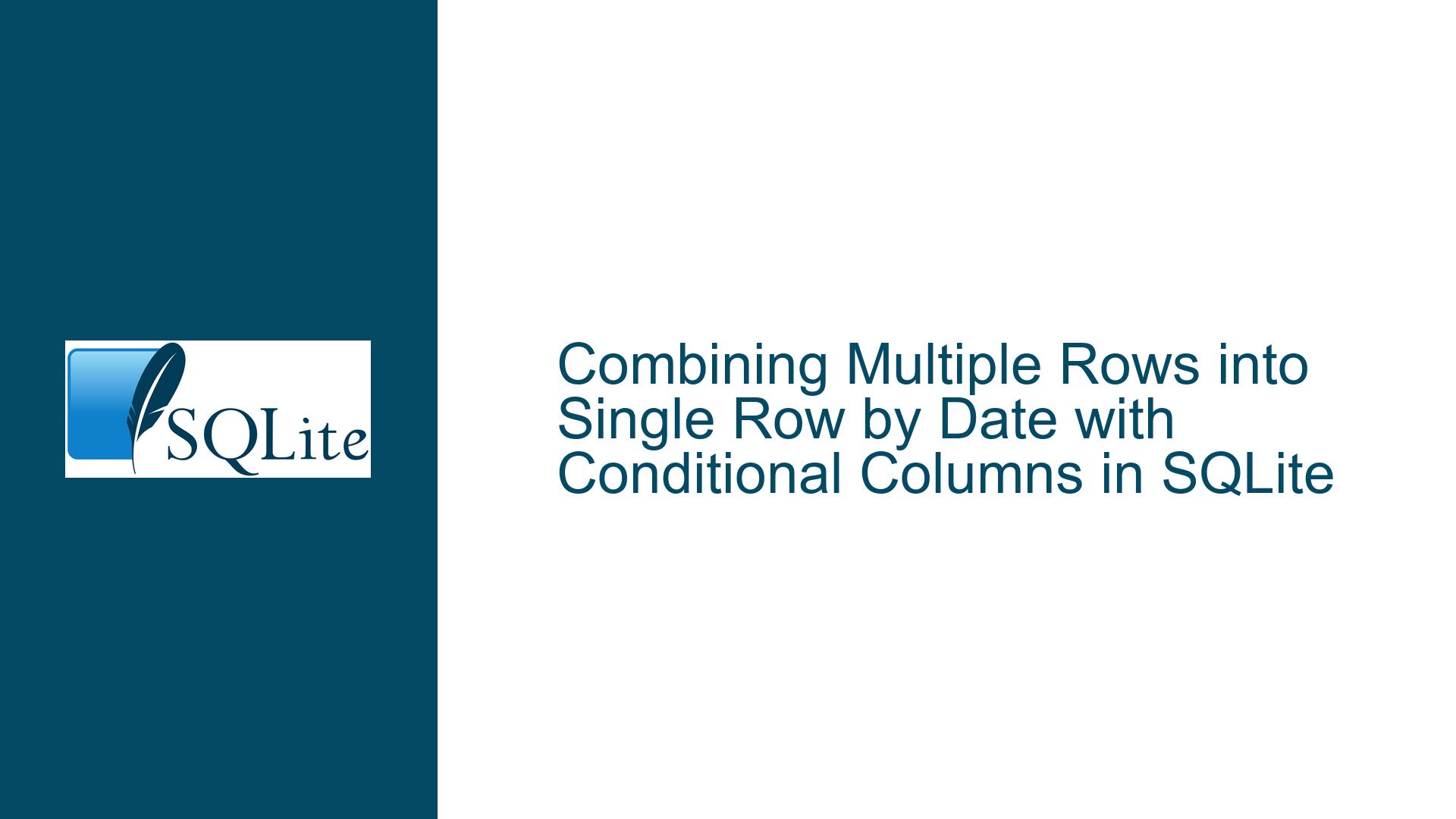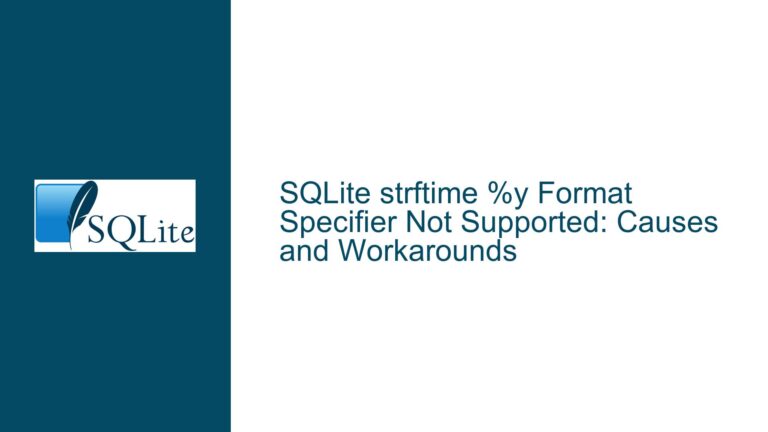Combining Multiple Rows into Single Row by Date with Conditional Columns in SQLite
Aggregating Conditional Column Values into Single Rows by Date
Issue Overview: Conditional Columns Producing Multiple Rows per Date
The problem arises when querying a table to create two conditional columns (T4 and TSH) based on patterns in a text field (TERM_TEXT). For entries sharing the same ENTRY_DATE, the query returns separate rows for each matched condition instead of consolidating them into a single row. For example, an ENTRY_DATE with both T4 and TSH values produces two rows: one with T4 populated and TSH as NULL, and another with TSH populated and T4 as NULL. The goal is to merge these rows into one row per ENTRY_DATE with non-NULL values in both columns where applicable.
This issue stems from the absence of row aggregation in the original query. Without explicit grouping, SQLite treats each row matching the WHERE clause independently, generating separate rows for each CASE condition matched. The database engine has no inherent logic to infer that rows with the same ENTRY_DATE should be merged unless instructed via aggregation functions or GROUP BY clauses. The challenge lies in ensuring that all relevant values for a given date are combined into a single row while preserving the conditional logic for T4 and TSH.
Key factors influencing this behavior include:
- Data Uniqueness Constraints: If the table allows multiple rows with the same
ID,ENTRY_DATE, andTERM_TEXT, aggregation becomes more complex. However, if(ID, ENTRY_DATE, TERM_TEXT)is unique (as confirmed by the user), this simplifies aggregation since eachTERM_TEXTpattern (*T4*or*TSH*) will have at most one row perENTRY_DATE. - Conditional Column Logic: The
CASEstatements createT4andTSHcolumns, but without aggregation, these columns exist only per row, not perENTRY_DATE. - Filtering Logic: The original
WHEREclause includes(T4 > 0 OR TSH > 0), which references aliases defined in theSELECTclause. This is technically invalid in standard SQL, as theWHEREclause executes before aliases are resolved. However, SQLite’s parser allows this in certain contexts, leading to potential confusion.
Possible Causes: Misaligned Aggregation and Filtering Logic
- Missing Grouping Mechanism: The absence of a
GROUP BYclause prevents SQLite from consolidating rows byENTRY_DATE. Each row is treated as distinct, even when dates overlap. - Incorrect Use of Aliases in Filters: Referencing
T4andTSH(aliases) directly in theWHEREclause violates SQL’s execution order. Filters are applied beforeSELECTaliases are resolved, which can lead to unexpected results or errors in stricter SQL environments. - Unaccounted Overlapping Conditions: If a single row’s
TERM_TEXTmatches both*T4*and*TSH*(e.g.,T4TSH), bothCASEstatements would populate their respective columns. However, the user confirmed this scenario is impossible, ensuring no overlaps exist. - Filtering Before Aggregation: The original
WHEREclause filters individual rows before aggregation, potentially excluding rows that would contribute to the aggregatedT4orTSHvalues. For example, a row withT4 = 0andTSH = 5would be excluded byWHERE (T4 > 0 OR TSH > 0), even though the aggregatedTSHvalue for that date is valid.
Troubleshooting Steps, Solutions & Fixes: Implementing Row Consolidation via Aggregation
Step 1: Group Rows by Entry Date
Use GROUP BY ENTRY_DATE to merge rows sharing the same date. This ensures one row per ENTRY_DATE, which is the foundational step for consolidating values.
Step 2: Apply Aggregation Functions to Conditional Columns
Wrap the CASE statements in aggregation functions like MAX() or MIN(). Since (ID, ENTRY_DATE, TERM_TEXT) is unique, each ENTRY_DATE group will have at most one non-NULL value for T4 and TSH. MAX() returns the non-NULL value if present, effectively collapsing the rows.
Example Query:
SELECT ENTRY_DATE,
MAX(CASE WHEN TERM_TEXT GLOB '*T4*' THEN NUMERIC_VALUE END) AS T4,
MAX(CASE WHEN TERM_TEXT GLOB '*TSH*' THEN NUMERIC_VALUE END) AS TSH
FROM NUM_VALUES
WHERE ID = 42
GROUP BY ENTRY_DATE
HAVING T4 > 0 OR TSH > 0
ORDER BY ENTRY_DATE ASC;
Key Adjustments:
- Aggregation Functions:
MAX()is used here, butMIN()orSUM()would also work, as each group has at most one non-NULLvalue. - Filtering with
HAVING: Replace theWHEREclause’s alias-based filter withHAVING, which operates on aggregated values. This ensures rows are filtered after aggregation, retaining dates where eitherT4orTSHis valid.
Step 3: Validate Data Uniqueness Assumptions
Confirm that (ID, ENTRY_DATE, TERM_TEXT) is unique. If duplicates exist, the aggregation may produce incorrect results. For example, multiple T4 entries for the same date would cause MAX() to return the highest value, which might not be intended.
Step 4: Address Filtering Logic
If pre-aggregation filtering is required (e.g., excluding rows where NUMERIC_VALUE ≤ 0), apply this in the WHERE clause using the raw NUMERIC_VALUE field:
WHERE ID = 42 AND (
(TERM_TEXT GLOB '*T4*' AND NUMERIC_VALUE > 0) OR
(TERM_TEXT GLOB '*TSH*' AND NUMERIC_VALUE > 0)
)
This ensures only valid values are included before aggregation.
Step 5: Handle Edge Cases
- Zero Values: If
NUMERIC_VALUEcan be zero, adjust theHAVINGclause toHAVING COALESCE(T4, 0) > 0 OR COALESCE(TSH, 0) > 0to handleNULLvalues. - Case Sensitivity:
GLOBis case-sensitive. IfTERM_TEXThas mixed-case values (e.g.,t4orTsh), useLIKEwithCOLLATE NOCASE:CASE WHEN TERM_TEXT LIKE '%T4%' COLLATE NOCASE THEN ...
Step 6: Optimize for Performance
- Indexing: Add indexes on
(ID, ENTRY_DATE, TERM_TEXT)to speed up filtering and grouping. - Avoiding Full Scans: Ensure the
WHEREclause is sargable (e.g., usingTERM_TEXT GLOB '*T4*'efficiently).
Alternative Approaches
Self-Joins: Join the table to itself on
ENTRY_DATE, filtering one instance forT4and another forTSH:SELECT T4.ENTRY_DATE, T4.NUMERIC_VALUE AS T4, TSH.NUMERIC_VALUE AS TSH FROM NUM_VALUES AS T4 LEFT JOIN NUM_VALUES AS TSH ON T4.ENTRY_DATE = TSH.ENTRY_DATE AND TSH.TERM_TEXT GLOB '*TSH*' AND TSH.ID = 42 WHERE T4.TERM_TEXT GLOB '*T4*' AND T4.ID = 42This method avoids aggregation but requires careful handling of
NULLvalues and duplicates.Pivot Tables: Use SQLite’s
JSON_GROUP_ARRAYorGROUP_CONCATfor dynamic pivoting if the number ofTERM_TEXTpatterns is variable.
Final Solution
The optimal fix is the aggregated query with GROUP BY and MAX(), as it efficiently consolidates rows while preserving clarity. This approach leverages SQLite’s strengths in aggregation and grouping, ensuring scalability and correctness under the given uniqueness constraints.






